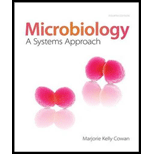
Microbiology: A Systems Approach
4th Edition
ISBN: 9780073402437
Author: Marjorie Kelly Cowan Professor
Publisher: McGraw-Hill Education
expand_more
expand_more
format_list_bulleted
Concept explainers
Question
Chapter 16.5, Problem 14AYP
Summary Introduction
To identify:
A type IV delayed hypersensitivity reaction, and describe the role of T cells in the pathogenesis of this condition.
Concept introduction:
Type IV hypersensitivities result observed when T cells respond to antigens displayed on the tissue of the host or transplanted foreign cells. Type IV hypersensitivity is also known as delayed hypersensitivity because, the symptoms arise several days after the second contact with an antigen.
Expert Solution & Answer
Want to see the full answer?
Check out a sample textbook solution
Students have asked these similar questions
its an open book assignemnt
Describe two different gene regulation mechanisms involving methylation
What is behavioral adapt
Chapter 16 Solutions
Microbiology: A Systems Approach
Ch. 16.1 - Define immunopathology, and describe the two major...Ch. 16.1 - Prob. 2AYPCh. 16.2 - Prob. 3AYPCh. 16.2 - Outline the steps of a type I allergic response,...Ch. 16.2 - Identify three conditions caused by IgE-mediated...Ch. 16.2 - Prob. 6AYPCh. 16.2 - Prob. 7AYPCh. 16.2 - Prob. 8AYPCh. 16.3 - Prob. 2CFCh. 16.3 - List the three immune components causing cell...
Ch. 16.3 - Prob. 10AYPCh. 16.3 - Prob. 11AYPCh. 16.4 - Prob. 12AYPCh. 16.4 - Prob. 13AYPCh. 16.5 - Prob. 14AYPCh. 16.5 - List four classes of grafts, and explain how host...Ch. 16.6 - Prob. 16AYPCh. 16.6 - Prob. 17AYPCh. 16.7 - Prob. 18AYPCh. 16.7 - Prob. 19AYPCh. 16.7 - Prob. 20AYPCh. 16 - Prob. 1CFCh. 16 - Prob. 1MCQCh. 16 - Prob. 2MCQCh. 16 - The contact with allergen that results in symptoms...Ch. 16 - Prob. 4MCQCh. 16 - Prob. 5MCQCh. 16 - Prob. 6MCQCh. 16 - Prob. 7MCQCh. 16 - Prob. 8MCQCh. 16 - Prob. 9MCQCh. 16 - Prob. 10MCQCh. 16 - Prob. 11TFCh. 16 - Prob. 12TFCh. 16 - Prob. 13TFCh. 16 - Prob. 14TFCh. 16 - Prob. 15TFCh. 16 - Prob. 1CTQCh. 16 - Prob. 2CTQCh. 16 - Prob. 3CTQCh. 16 - Prob. 4CTQCh. 16 - Prob. 5CTQCh. 16 - Prob. 6CTQCh. 16 - Prob. 7CTQCh. 16 - Prob. 8CTQCh. 16 - Prob. 9CTQCh. 16 - Prob. 10CTQCh. 16 - Prob. 1CCCh. 16 - Prob. 2CCCh. 16 - Prob. 3CCCh. 16 - From chapter 15. figure 15.1. How would a persons...Ch. 16 - Prob. 2VCCh. 16 - Prob. 1CM
Knowledge Booster
Learn more about
Need a deep-dive on the concept behind this application? Look no further. Learn more about this topic, biology and related others by exploring similar questions and additional content below.Similar questions
- 22. Which of the following mutant proteins is expected to have a dominant negative effect when over- expressed in normal cells? a. mutant PI3-kinase that lacks the SH2 domain but retains the kinase function b. mutant Grb2 protein that cannot bind to RTK c. mutant RTK that lacks the extracellular domain d. mutant PDK that has the PH domain but lost the kinase function e. all of the abovearrow_forwardWhat is the label ?arrow_forwardCan you described the image? Can you explain the question as well their answer and how to get to an answer to an problem like this?arrow_forward
- Describe the principle of homeostasis.arrow_forwardExplain how the hormones of the glands listed below travel around the body to target organs and tissues : Pituitary gland Hypothalamus Thyroid Parathyroid Adrenal Pineal Pancreas(islets of langerhans) Gonads (testes and ovaries) Placentaarrow_forwardWhat are the functions of the hormones produced in the glands listed below: Pituitary gland Hypothalamus Thyroid Parathyroid Adrenal Pineal Pancreas(islets of langerhans) Gonads (testes and ovaries) Placentaarrow_forward
- Describe the hormones produced in the glands listed below: Pituitary gland Hypothalamus Thyroid Parathyroid Adrenal Pineal Pancreas(islets of langerhans) Gonads (testes and ovaries) Placentaarrow_forwardPlease help me calculate drug dosage from the following information: Patient weight: 35 pounds, so 15.9 kilograms (got this by dividing 35 pounds by 2.2 kilograms) Drug dose: 0.05mg/kg Drug concentration: 2mg/mLarrow_forwardA 25-year-old woman presents to the emergency department with a 2-day history of fever, chills, severe headache, and confusion. She recently returned from a trip to sub-Saharan Africa, where she did not take malaria prophylaxis. On examination, she is febrile (39.8°C/103.6°F) and hypotensive. Laboratory studies reveal hemoglobin of 8.0 g/dL, platelet count of 50,000/μL, and evidence of hemoglobinuria. A peripheral blood smear shows ring forms and banana-shaped gametocytes. Which of the following Plasmodium species is most likely responsible for her severe symptoms? A. Plasmodium vivax B. Plasmodium ovale C. Plasmodium malariae D. Plasmodium falciparumarrow_forward
arrow_back_ios
SEE MORE QUESTIONS
arrow_forward_ios
Recommended textbooks for you
 Human Biology (MindTap Course List)BiologyISBN:9781305112100Author:Cecie Starr, Beverly McMillanPublisher:Cengage Learning
Human Biology (MindTap Course List)BiologyISBN:9781305112100Author:Cecie Starr, Beverly McMillanPublisher:Cengage Learning
 Human Physiology: From Cells to Systems (MindTap ...BiologyISBN:9781285866932Author:Lauralee SherwoodPublisher:Cengage Learning
Human Physiology: From Cells to Systems (MindTap ...BiologyISBN:9781285866932Author:Lauralee SherwoodPublisher:Cengage Learning Human Heredity: Principles and Issues (MindTap Co...BiologyISBN:9781305251052Author:Michael CummingsPublisher:Cengage Learning
Human Heredity: Principles and Issues (MindTap Co...BiologyISBN:9781305251052Author:Michael CummingsPublisher:Cengage Learning

Human Biology (MindTap Course List)
Biology
ISBN:9781305112100
Author:Cecie Starr, Beverly McMillan
Publisher:Cengage Learning


Human Physiology: From Cells to Systems (MindTap ...
Biology
ISBN:9781285866932
Author:Lauralee Sherwood
Publisher:Cengage Learning

Human Heredity: Principles and Issues (MindTap Co...
Biology
ISBN:9781305251052
Author:Michael Cummings
Publisher:Cengage Learning


Immune System Diseases and Disorders; Author: Heather Davis;https://www.youtube.com/watch?v=3lIkxNv7MVI;License: Standard youtube license